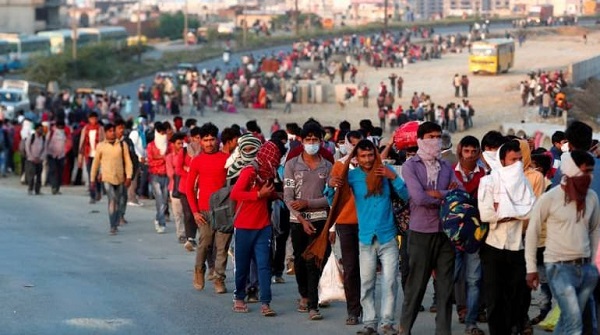P.K. Anand, Research Associate, ICS
The ‘visibility’ of the migrant workers is the biggest urban predicament that is being witnessed during the nation-wide lockdown, which has now crossed 50 days. The images of their ‘reverse migration’ — whether entirely by foot, or through modes of transportation that are heart-wrenching — lay bare the desperations and anxieties emerging from the loss of livelihood and security.
Not that many of these journeys have happy endings — deaths due to exhaustion, or accidents leave behind more than just a trail of dead bodies. It is equally significant that since the lockdown started on March 25, there also exists a long list of casualties that cannot be pinned on the virus per se — including those related to mental health, often left at the periphery.
The brutal social experiment that is the pandemic has only reinforced and exacerbated the systemic exclusion and dispossession of circular/seasonal migrant workers/footloose workers, who inhabit Indian cities. A report titled Unlocking the Urban, released by Aajeevika Bureau —a non-profit organisation working among seasonal migrants in western India — released on May 1, highlighted the longstanding vulnerabilities of rural-urban migrants in cities. They often receive less than minimum wages, are engaged in manual work which last for long hours, which, are often even dangerous.
They remain unaccounted for by national statistics and are invisible to city-level administrations; precarity undergirds their working and living spaces, rendering them ineligible for social schemes and welfare programmes. These further lead to them being denied access to urban residence and governance; their survival in the cities is dependent on daily negotiations with informal actors, ranging from petty contractors to security guards, and even landlords.
The socio-spatial exclusion of migrants from Indian cities, and their statelessness in some ways, mirrors the nongmin gong (peasant workers) in China’s urban spaces, pejoratively called ‘floating population’; though the Chinese state has changed the terminology to xin shimin (new city residents) in order to fully ‘integrate’ them into urban centres, the desired results have not followed.
China’s Rural-Urban Dichotomy
The demarcation of citizenship in China into rural and urban is a legacy of socialist planning. In 1958, the hukou(registered residence permits), was introduced to regulate the flow of resources, especially labour, and sustain an agrarian countryside, while the State subsidised urban living. The economic reforms of the 1980s led to easing of rural-to-urban mobility, which, in turn, kick-started the long journey of labourers from the rural areas to the industries and companies in coastal provinces. The migrant workers have been crucial in the growth of many megacities in China today.
However, this infrastructural and economic growth of Chinese cities happened even as the migrant workers remained peripheral in China’s urbanity. The urban hukou — the foundation for a well-entrenched city life with access to public services, healthcare and education — is highly stratified and segregated, with eligibility based on the level of education, skills and status. The hukoucreates a division between privileged and entitled urban residents and the migrant workers. Though the migrant workers are tagged as ‘essential’, in reality they are ‘placeless’ and unable to make claims for a ‘right to the city’. The constant fear of eviction from their informal neighbourhoods and being at the receiving end of law enforcement’s brutal high-handedness, mirror the story of their Indian counterparts. Furthermore, the marginalisation of migrants in city spaces has also impacted the lives of their children in claiming access to healthcare and education.
Urban Citizenship
While the high level of decentralisation in China’s political-administrative system give the local governments significant decision-making powers, city governments — especially those in the megacities — remain intransigent in reforming the hukousystem. Beijing has repeatedly mentioned the need to reform the system but it more or less remains on paper. While small and medium sized cities have experimented with various models and pilot programmes, there remains reluctance from the big cities. It highlights the skewed nature of China’s tax and revenue systems favouring the central government, while the local governments bear the fiscal responsibilities. Thus, the big cities are resistant to reforms that add to their burden.
By the same count, with laws and regulations largely divided between the Union government and the state governments in India, local bodies (such as municipalities) are rendered powerless, without significant responsibilities. Such disempowerment of cities create constraints in developing specific and contextual regulations (for instance, in many cities migrant workers are not even enumerated).
Clearly, while political systems, level of State capacity and trajectory of development may vary, cities in China and India have retained many common threads of socio-spatial exclusion of migrant workers.
Originally Published as ‘Urban Spaces | Migrant workers remains invisible in India and China’ in Moneycontrol.com, 21 May 2020
